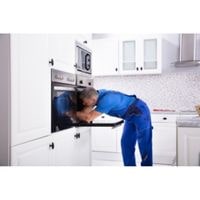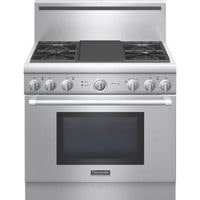Thermador self cleaning oven problem. Thermador, a company that produces high-end appliances for the home by Bosch and Siemens Household Appliances, offers different styles of ovens.
One type of Thermador oven is a self-cleaning oven. Self-cleaning ovens use temperatures between 425 and 850 degrees Fahrenheit to clean themselves effectively.
Another type of Thermador oven is a convection/steam microwave combination oven. It functions as either a standard microwave or a full convection/steam oven with just one touch of a button.
Thermador self-cleaning oven problem

Let your oven cool down before starting another self-cleaning cycle.
If the self-cleaning mode does not work, make sure the latch is engaged, and make sure the cleaning button has been pressed.
If your door won’t latch, then you must contact a technician. Allow your oven to cool down before trying to disengage the lock.
It is normal for your oven not to be completely clean if it was extremely dirty.
Run the self-cleaning cycle again and for a longer time. Below we will discuss some common issues that users encounter when using an oven’s self-cleaning mode and how to solve them:
Door lock motor and switch assembly problem
During the oven’s self-cleaning cycle, the door lock motor activates and locks the door so that it stays securely shut.
If you’d like to be able to get into that oven before the cleaning is done. The oven door will not unlock once the self-cleaning cycle is completed if the door lock motor or switch assembly is defective.
Then you should probably just not use that feature, or if it’s possible on your particular model then make sure to check your owner’s manual to find out how to remove certain parts so you can let yourself in (usually all it takes is a screwdriver).
Faulty Temperature Control Thermostat
The self-cleaning cycle, which is activated after the door is closed, has three levels of temperature. When you press this button to turn on the oven for cleaning, there are actually three different heat settings.
The self-cleaning cycle also shuts off differently than any other oven setting. In order to prevent accidentally leaving your oven on high heat and wasting energy.
You need an oven thermometer that takes all of these factors into consideration when testing your oven’s temperature.
Defective Oven Control Board
The oven has a printed circuit board that delivers power to the heating elements.
This circuit board, or PCB, relays voltage to each component based on user settings and sensor input. If there is a malfunction with the PCB, this relay may not be taking place.
The Door Switch does not have continuity
A defective door switch could cause problems with the oven’s locking mechanism. This issue often arises during a self-cleaning cycle which is why you may notice the oven not going through its cleaning process at certain times.
If the stove is unable to lock, it’s likely due to a faulty door switch which can be tested by using a multimeter. If the door switch doesn’t have continuity, it needs to be replaced.
Below Thermal Fuse
The thermal fuse is a safety feature that protects the oven from experiencing rapid extreme variations in temperature (an anomaly). If the oven experiences an anomaly, the thermal fuse trips to shut off power to the oven.
The thermal fuse is not resettable if it blows, you must replace it. To test if the thermal fuse has a problem with its continuity.
Use a multimeter to check for proper connectivity between its electrical terminals. Note: if there’s no continuity indicated with a multimeter, replace the thermal fuse.
Related Guides
